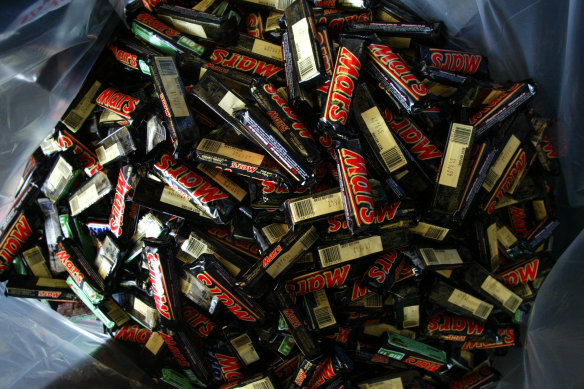
Prolific dealmaking
Spearheading this expansion through acquisitions over the past three decades has been Valerie Mars, the 65-year-old great-granddaughter of Franklin Clarence Mars, who started the company as a chocolate factory in 1911, according to people familiar with the matter.

The Mars conglomerate has agreed on a $US36 billion deal to buy Kellanova, the maker of Pringles.Credit: Dean Sewell
As most Mars family members retired from the company and installed trusted lieutenants at the helm, Valerie remained and helped spearhead most of the company’s major deals, including the $US23 billion purchase of chewing gum maker Wrigley Jr. Company in 2008, a deal with financial backing from Warren Buffett’s Berkshire Hathaway.
As a result, the company’s annual net sales grew from a little over $US10 billion when Valerie Mars joined it in 1996 to more than $US50 billion this year.
As she prepared to stand down as senior vice president of corporate development later this year, Valerie Mars helped the company’s chief executive Poul Weihrauch, who led the negotiations on the deal with Kellanova chief executive Steve Cahillane, the sources said.
The company behind Snickers and Twix already had big market share in the chocolate, gum and pet nutrition categories, and was looking to invest in new lines of business, such as salty snacks and cereal internationally, where Kellanova, producer of Pringles, Cheez-It and Kellogg’s corn flakes, is strong, the companies said.
While some of Mars’ rivals also considered a deal for Kellanova, they could not get comfortable with the purchase price being asked or the lengthy regulatory review that is expected, the sources said. While Mars and Kellanova hope antitrust regulators will clear the deal because of their limited product overlap in the first half of 2025, they have given themselves up to two years to complete it in case of protracted scrutiny, according to a Securities and Exchange Commission filing.
High hopes
The negotiations between the two companies started in the past few months, after Kellanova completed its spin from WK Kellogg, which was left with the parent company’s cereal business in North America, the sources said.

Valerie Mars, the 65-year-old great-granddaughter of company founder Franklin Clarence Mars, is said to be spearheading the company’s deals.
Kellanova’s Cahillane and board of directors had high hopes for the new company’s stock, and Mars did not believe it could meet their price expectations, the sources added.
But Kellanova’s shares struggled after the spin-off in October, trading below their debut price for much of the time since, as investors worried about price inflation and the impact of weight-loss drugs weighing on consumer demand.
It was not until the Chicago-based company raised its annual organic sales and profit forecasts earlier this month and Reuters subsequently reported that Mars was looking to acquire Kellanova that the shares’ value grew by about a third.
The purchase price that Mars ended up offering, equivalent to 16.4 times Kellanova’s adjusted 12-month cash flow, was in line with other recent deals in the sector, and enough to convince the top company’s shareholders, the W.K. Kellogg Foundation Trust and the Gunds – another wealthy family – to back the deal, the sources said.
Loading
Most of Mars’ rivals did not have the deep pockets to pull off a transaction of this size. Mars had $US6.6 billion in cash on hand as of the end of December, as well as access to $US4 billion in credit lines, according to credit ratings agency S&P Global. It also convinced banks to lend it as much as $US29 billion for the deal, according to an SEC filing.
Mars’ annual dividends are only about $US600 million – as a percentage of its cash flow, well below the figures most of its consumer packaged goods peers pay out, according to S&P – reflecting the family’s desire to reinvest in the business.
Reuters
The Business Briefing newsletter delivers major stories, exclusive coverage and expert opinion. Sign up to get it every weekday morning.









 Add Category
Add Category